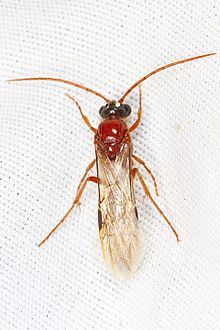Tiphiidae
| Tiphiid wasps | |
|---|---|

| |
| Tiphia sp. | |
| Scientific classification | |
| Kingdom: | Animalia |
| Phylum: | Arthropoda |
| Class: | Insecta |
| Order: | Hymenoptera |
| Superfamily: | Tiphioidea |
| Family: | Tiphiidae |
| Subfamilies | |
The Tiphiidae (also known as the tiphiid wasps) are a family of large, solitary wasps whose larvae are parasitoids of various beetle larvae, especially those in the superfamily Scarabaeoidea. Until recently, this family contained several additional subfamilies, but multiple studies have independently confirmed that these comprise a separate lineage, and are now classified in the family Thynnidae.[1][2]
The females of some Brachycistidinae are wingless, and hunt ground-dwelling (fossorial) beetle larvae. The prey is paralysed with the female's sting, and an egg is lain on it so the wasp larva has a ready supply of food. As some of the ground-dwelling scarab species attacked by tiphiids are pests, some of these wasps are considered beneficial as biological control agents.
Taxonomy[]
Tiphiid genera are classified as follows: [3][4][5]


Subfamily Brachycistidinae[]
- Wasbauer, 1958
- Baker, 1907
- Malloch, 1926
- Fox, 1893
- Kimsey & Wasbauer 1999
- Krombein, 1942
- Wasbauer, 1968
- Mickel & Krombein, 1942
- Wasbauer, 1968
- Kimsey & Wasbauer, 1999
- Kimsey & Wasbauer, 1999
- Mickel & Krombein, 1942
Subfamily Tiphiinae[]
- Nagy, 1974
- Cameron, 1907
- Romand, 1835
- Nagy, 1967
- Pate, 1947
- Nagy, 1967
- Allen, 1972
- Kimsey, 1993
- Malloch, 1918
- Sichel, 1864
- Ashmead 1903
- Tiphia Fabricius, 1775
Examples[]
- Tiphia femorata Linden 1827
- Tiphia minuta Fabricius, 1775
References[]
- ^ Pilgrim, E.; von Dohlen, C.; Pitts, J. (2008). "Molecular phylogenetics of Vespoidea indicate paraphyly of the superfamily and novel relationships of its component families and subfamilies". Zoologica Scripta. 37 (5): 539–560. doi:10.1111/j.1463-6409.2008.00340.x. S2CID 85905070.
- ^ Johnson, B.R.; et al. (2013). "Phylogenomics Resolves Evolutionary Relationships among Ants, Bees, and Wasps". Current Biology. 23 (20): 2058–2062. doi:10.1016/j.cub.2013.08.050. PMID 24094856.
- ^ "Taxonomy for Tiphiinae". insectoid.info. Retrieved 13 May 2017.
- ^ "Tiphiinae". Fauna Europaea. Retrieved 13 May 2017.
- ^ Lynn S. Kimsey; Marius Wasbauer (2006). "Phylogeny and Checklist of the Nocturnal Tiphiids of the Western Hemisphere (Hymenoptera: Tiphiidae: Brachycistidinae)". Journal of Hymenoptera Research. 15 (1): 9–25.
Further reading[]
- Arnett, R. H. Jr. (2000) Segunda edición. American insects. CRC Press, Boca Raton, Londres,New York, Washington, D. C. ISBN 0-8493-0212-9
- Borror, D. J., DeLong, D. M., Triplehorn, C. A.(1976) cuarta edición. An introduction to the study of insects. Holt, Rinehart and Winston. New York, Chicago. ISBN 0-03-088406-3
- Bugguide.net. Family Tiphiidae - Tiphiid Wasps
| Wikimedia Commons has media related to Tiphiidae. |
- Tiphiidae
- Apocrita families
- Insects used as insect pest control agents